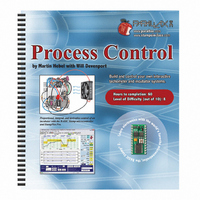122-28176 Parallax Inc, 122-28176 Datasheet - Page 258

122-28176
Manufacturer Part Number
122-28176
Description
GUIDE STUDENT PROCESS CONTROL
Manufacturer
Parallax Inc
Specifications of 122-28176
Accessory Type
Manual
Product
Microcontroller Accessories
Lead Free Status / RoHS Status
Contains lead / RoHS non-compliant
For Use With/related Products
Propeller Education (PE) Kit
Lead Free Status / RoHS Status
Lead free / RoHS Compliant, Contains lead / RoHS non-compliant
- Current page: 258 of 330
- Download datasheet (11Mb)
well as the driving conditions.
chapter.
Conditions (or disturbances on our system) can change very rapidly; such as when the car
suddenly encounters a hill. Or may be very slow; such as tire wear reducing efficiency.
PID control can measure and take action on:
The sum of these three evaluations comprises the output drive in an attempt to maintain a
system in equilibrium. Figure 8-1 illustrates the evaluation and control of a system for
PID control.
The classic PID formula for calculating the controller output is as follows:
or
Where:
*(Earlier E was used for Energy. Symbols have multiple uses).
1. How far from the setpoint a system is, or the magnitude of the error.
2. The duration for which an error remains.
3. How quickly an error occurs in the system, or the "rate" of change.
DRIVE
Co = controller output or drive
Bias = User defined drive
E = Amount of Error*
t= Time
K
K
K
dE = Change in error
dt = Change in time
Co
P
I
D
= integral gain
PID
= proportional gain
= derivative gain
=
TOTAL
Bias
= DRIVE
+
K
P
E
+
BIAS
K
I
Keep this example in mind as you continue through this
+ DRIVE
∫
Edt
+
K
PROPORTIONAL
D
dE
dt
+ DRIVE
INTEGRAL
+ DRIVE
DERIVATIVE
Related parts for 122-28176
Image
Part Number
Description
Manufacturer
Datasheet
Request
R

Part Number:
Description:
MANUAL FOR SUMOBOT
Manufacturer:
Parallax Inc
Datasheet:

Part Number:
Description:
GUIDE STUDENT SMART SENSORS
Manufacturer:
Parallax Inc
Datasheet:

Part Number:
Description:
MANUAL PROPELLER
Manufacturer:
Parallax Inc
Datasheet:

Part Number:
Description:
LEAD WIRES FLYING CABLE III/IV
Manufacturer:
Xilinx Inc
Datasheet:

Part Number:
Description:
BOARD ADAPTER AND FLY LEADS
Manufacturer:
Xilinx Inc
Datasheet:

Part Number:
Description:
PLATFORM CABLE USB II
Manufacturer:
Xilinx Inc
Datasheet:

Part Number:
Description:
KIT STARTER COOLRUNNER-II BUNDLE
Manufacturer:
Xilinx Inc
Datasheet:

Part Number:
Description:
Microcontroller Modules & Accessories DISCONTINUED BY PARALLAX
Manufacturer:
Parallax Inc

Part Number:
Description:
Microcontroller Modules & Accessories DISCONTINUED BY PARALLAX
Manufacturer:
Parallax Inc

Part Number:
Description:
BOOK UNDERSTANDING SIGNALS
Manufacturer:
Parallax Inc
Datasheet:

Part Number:
Description:
BOARD EXPERIMENT+LCD NX-1000
Manufacturer:
Parallax Inc
Datasheet:

Part Number:
Description:
IC MCU 2K FLASH 50MHZ SO-18
Manufacturer:
Parallax Inc
Datasheet:












